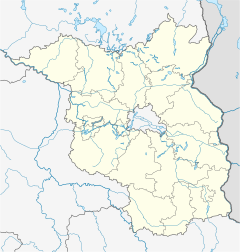This article includes a list of general references, but it lacks sufficient corresponding inline citations. (January 2012) |
| Cecilienhof Palace | |
|---|---|
Schloss Cecilienhof | |
 Cecilienhof Palace seen from the commemorative courtyard, with the Soviet red star in the foreground | |
| General information | |
| Type | Palace |
| Architectural style | Tudor Revival |
| Town or city | Potsdam |
| Country | Germany |
| Coordinates | 52°25′09″N 13°04′15″E / 52.41917°N 13.07083°E |
| Construction started | April 1914 |
| Completed | August 1917 |
| Cost | 1,498,000 Reichsmark |
| Client | Emperor Wilhelm II |
| Landlord | Stiftung Preussische Schlösser und Gärten |
| Design and construction | |
| Architect(s) | Paul Schultze-Naumburg |
| Main contractor | Saalecker Werkstätten |
Cecilienhof Palace (German: Schloss Cecilienhof) is a palace in Potsdam, Brandenburg, Germany, built from 1914 to 1917 in the layout of an English Tudor manor house. Cecilienhof was the last palace built by the House of Hohenzollern that ruled the Kingdom of Prussia and the German Empire, until the end of World War I. It is famous for having been the location of the Potsdam Conference in 1945, in which the leaders of the Soviet Union, the United Kingdom and the United States made important decisions affecting the shape of post-World War II Europe and Asia. Cecilienhof has been part of the Palaces and Parks of Potsdam and Berlin UNESCO World Heritage Site, since 1990.[1]
- ^ "Palaces and Parks of Potsdam and Berlin". UNESCO World Heritage Centre. United Nations Educational, Scientific, and Cultural Organization. Retrieved 12 Jun 2022.

